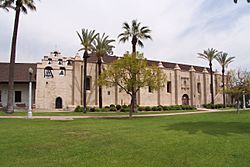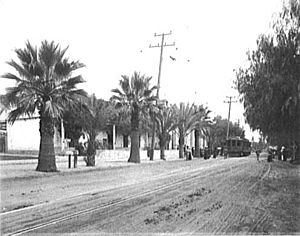Mission San Gabriel Arcángel facts for kids

A view of Mission San Gabriel Arcángel in April 2005. The open stairway at the far right leads to the choir loft, and to the left is the six-bell campanario ("bell wall") that was built after the original bell structure, located at the far end of the church, toppled during the 1812 San Juan Capistrano earthquake.
|
|
| Location | 428 South Mission Dr. San Gabriel, California 91776-1299 |
|---|---|
| Coordinates | 34°05′48″N 118°06′24″W / 34.09667°N 118.10667°W |
| Name as founded | La Misión del Santo Príncipe el Arcángel, San Gabriel de los Temblores |
| English translation | The Mission of the Saintly Prince The Archangel, St. Gabriel of the Tremblors |
| Patron | Gabriel, Holy Prince of Archangels |
| Nickname(s) | "Pride of the Alta California Missions" "Mother of Agriculture in California" |
| Founding date | September 8, 1771 |
| Founding priest(s) | Pedro Benito Cambón and Ángel de la Somera (1st); Father Presidente Junípero Serra (2nd) |
| Founding Order | Fourth |
| Military district | First |
| Native tribe(s) Spanish name(s) |
Tongva Gabrieleño |
| Native place name(s) | 'Iisanchanga, Shevaanga |
| Baptisms | 7,825 |
| Marriages | 1,916 |
| Burials | 5,670 |
| Secularized | 1834 |
| Returned to the Church | 1859 |
| Governing body | Roman Catholic Archdiocese of Los Angeles |
| Current use | Chapel / Museum |
| Designated | 1971 |
| Reference no. | #71000158 |
| Reference no. | #158 |
| Website | |
| http://www.sangabrielmission.org | |
Mission San Gabriel Arcángel is a historic landmark in San Gabriel, California. It was the fourth of twenty-one Spanish missions in California. Spanish explorers founded it on September 8, 1771. The mission was named after the Archangel Gabriel. People sometimes called it the "Godmother of the Pueblo of Los Angeles."
The mission building has unique capped buttresses and tall, narrow windows. These features were designed by Antonio Cruzado. The main building was finished in 1805. A large stone cross stands in the center of the Campo Santo (cemetery). This cemetery was first used in 1778. It is the resting place for about 6,000 Native Americans.
An old Spanish story says that when the mission was founded, Tongva natives wanted to stop the Spanish. A priest showed them a painting of "Our Lady of Sorrows." The natives were so impressed by its beauty that they made peace. Today, this 300-year-old painting hangs near the altar in the mission's church.
History of Mission San Gabriel
Founding the Mission
In August 1771, Spanish soldiers and priests met Tongva Indians. One month later, on September 8, 1771, Mission San Gabriel was founded. It was started by Fray Ángel Fernández de la Somera and Fray Pedro Benito Cambón. The first location was near the Río Hondo. This spot is now called Misión Vieja or "Old Mission."
The mission was built with the help of Native American workers. These workers came from nearby Tongva villages. The mission aimed to teach them new farming methods and crafts. When the nearby Pueblo de los Ángeles was built in 1781, both the mission and the pueblo needed Native American workers.
Challenges and Relocation
In 1776, a big flood damaged the first mission complex. Because of this, the mission moved about five miles closer to the mountains. This new location is where San Gabriel is today. It was near the Tongva village of Toviscanga.
On December 8, 1812, strong earthquakes hit Southern California. The 1812 San Juan Capistrano earthquake caused the mission's three-bell tower to fall. A new, larger bell structure with six bells was then built.
Life at the Mission
Between 1771 and 1834, over 25,000 baptisms took place at San Gabriel. This was more than any other mission. The Franciscan missionaries introduced new ways of life to the Tongva people. This included religious teachings and new types of work. Sadly, many Tongva children did not live long at the mission. Nearly 6,000 Tongva people are buried in the mission grounds.
Some Native Americans found the mission life difficult. There were reports of people leaving the mission. For example, in 1808, some neophytes (new converts) left. A Spanish soldier tried to bring them back, but the village chief refused.

Later Years and Restoration
After 1834, the mission was no longer controlled by the church. Many of its buildings fell into disrepair. The vineyards and fences were damaged. For a time in the 1850s, parts of the mission were even used as a saloon.
From 1862 to 1908, the mission chapel served as a local church. Then, the Claretian Missionaries began to rebuild and restore the mission. In 1987, the 1987 Whittier Narrows earthquake caused more damage. Much of the mission has since been carefully restored.
On July 11, 2020, a fire destroyed the roof of the church. Luckily, some paintings and artifacts were saved because the mission was already being renovated. A man was later charged with setting the fire. The mission officially reopened in July 2023, after much repair work.
Mission Industries and Ranchos
Becoming Self-Sufficient
The main goal of the missions was to become self-sufficient. This meant they wanted to produce everything they needed. Farming was the most important activity. The mission priests taught Native Americans new farming methods. They also taught them mechanical skills and how to care for animals. The mission workers made all the goods and food they used. After 1811, the mission workers even helped support the government of California.
Ranchos and Outposts
The mission had many large farms called ranchos. These were used to raise cattle, sheep, and other animals. Some of these ranchos included San Pasqual, Santa Anita, and San Bernardino. Rancho San Gorgonio, established in 1824, was the farthest outpost of the San Gabriel Mission.
Many Native Americans lived in communities called rancherías. Some of the rancherías connected to Mission San Gabriel were Acuragna, Cahuenga, and Toviscanga.
To manage its large lands, Mission San Gabriel also set up smaller outposts called asistencias. These included Rancho Santa Ana del Chino and San Bernardino de Sena Estancia.
In 1816, the mission built a grist mill to grind grain. This building, called El Molino Viejo, is still standing today. It is now a museum and a historic landmark. Other mission activities included making leather, soap, tiles, and adobe bricks. They also wove cloth for blankets and clothes.
Mission Bells
Bells were very important in daily life at the mission. They rang to announce mealtimes and to call people to work. Bells also signaled religious services, births, and funerals. They even warned when a ship was arriving or a missionary was returning. Newcomers learned the special ways to ring the mission bells. The bells also helped people tell time.
A TV show episode called "The Bell of San Gabriel" featured the mission. It told the story of Father Miguel Sánchez. As a child, Miguel helped get money to make the mission bell sound sweeter. Years later, the sound of that bell saved his life in the desert.
Burials at the Mission
The Mission San Gabriel Arcángel Cemetery is the oldest Catholic cemetery in California. A large stone cross marks the center of the Campo Santo. It was first blessed in 1778. About 6,000 Native Americans are buried here. A small stone marks the grave of José de los Santos. He was the last Native American buried on the grounds in 1921, at 101 years old.
Many Franciscan priests who served at the mission are also buried here. Their remains are entombed at the foot of the altar. Important figures like Eulalia Pérez de Guillén Mariné are also buried at the mission. She was known as the "keeper of the keys" during Spanish rule. Victoria Reid, a respected Native American woman, is also buried here.
Exhibits and Tours
Visitors can explore the church, museum, and grounds. The adobe museum building was built in 1812. It was originally used for sleeping quarters and storing books. Inside, you can see mission relics, old books, and religious items.
The grounds show how the mission operated long ago. You can see indoor and outdoor kitchens, a winery, and water storage tanks. There are also vats for making soap and candles, and for tanning animal hides. The historic cemetery is also part of the tour. A gift shop is available for visitors.
See also
 In Spanish: Misión San Gabriel Arcángel para niños
In Spanish: Misión San Gabriel Arcángel para niños
- Spanish missions in California
- List of Spanish missions in California
- Mission San Francisco Solano (California)
- Nuestra Señora Reina de los Ángeles Asistencia
- El Molino Viejo
- San Bernardino Asistencia
- USNS Mission San Gabriel (AO-124) – a Mission Buenaventura-class fleet oiler built during World War II
- Eulalia Pérez de Guillén Mariné
- Hugo Reid
- San Gabriel Mission High School
- Henninger Flats
- Casa de San Pedro – formerly owned by the mission




